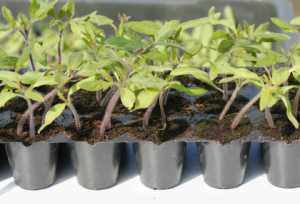This guest article on raising tomato plants from seed is by Philip Swindells. When reading this, do remember that the author is writing for an international audience and in the UK growing tomatoes outdoors is always chancy. Late unexpected frosts, a cool summer and blight can all take their toll.
Tomatoes, although technically short-lived perennials, are treated as annuals and raised from seed each year. Getting them off to a good start is the first step to a great crop.

Tomato Seedlings started in Modules Given warmth, good light and a damp friable growing medium tomatoes are very easy to raise from seed
Tomatoes, although technically short-lived perennials, are treated as annuals and raised from seed each year. They are sub-tropical plants that require a consistent temperature of at least 13ºC (55ºF) in order to germinate successfully, but a temperature of 21ºC (70ºF) will produce much quicker emergence and is generally preferred.
For most gardeners, even those that live in warmer districts where tomatoes are cultivated outdoors from their very early stages of growth, it is usual to start the seeds off in pans or flats (seed trays)of compost under controlled conditions.
Please note: recent trials have shown that tomatoes germinated in seed trays or pots do far better if transplanted on within 6 days of germination
Starting Tomatoes in Modules
Tomatoes can be sown directly into the open ground, where the climate and soil conditions are suitable, but much better establishment of better quality plants always results from controlled seed raising and growing the seedlings during their initial stages of growth in independent modules or pots. Transplanting is easier and establishment is rapid.
Spacing of Tomato Seeds
As tomato seeds are large enough to handle individually, it is best to space them out on the surface of the prepared compost so that when they germinate they do not crowd each other. Also when they are pricked out there is no undue disturbance of the fragile root systems through them having become entangled with each other. A properly formulated seed compost is essential. A sterile medium of a texture and quality that will offer the best start for the germinating seeds.
Best Tomato Growing Compost
There are a number of different composts available, but for the hobby gardener a good soil-based seed compost is to be preferred to a soil-less one. Soil-based composts, although generally slower to warm-up, and often slightly impairing the speed of seed germination, usually yield the finest and strongest plants, especially for planting directly into the garden outdoors.
Plants that have been raised in a soil-less compost, which almost always comprises a high proportion of friable peat, often take time to adapt their roots to the more hostile and less forgiving medium of natural garden soil when planted in their permanent positions. Sometimes a check in growth occurs while the roots adapt, resulting in an impairment in the plant’s development.
Soil-based composts also overcome the problem, commonly encountered with tomato seedlings raised in a soil-less medium, of the seed coat sticking the two seed leaves together, often making them inseparable without causing damage. The seed coat is generally detached by the coarser soil-based medium as the seedlings emerge.
Transplanting Tomato Seedlings
Once the seedlings have their two seed leaves fully expanded they should be pricked out, ideally into individual modules or small pots, although they can spend two or three weeks pricked out into flats in order to save space when this is necessary.
About the author: Philip Swindells has over 40 years gardening experience. A former botanical garden curator and an international horticultural consultant, he has worked extensively in the UK, North America, the Middle East and Australia. The Author of more than 50 gardening books, he has been awarded a Quill and Trowel Award by the Garden Writers’ Association of America. He is also a former UK Garden Writer of the Year.
Further Information: Tomato Growing Guides
- Grow Unusual Tomatoes!
- Types of Tomatoes – An Introduction to Tomato Growing Part 1
- Sowing and Starting off Tomatoes – Introduction to Tomato Growing Part 2
- Growing Tomatoes in a Tomato Grow-house (Mini-Greenhouse)
- Growing Tomatoes in a Greenhouse
- Growing Tomatoes in the Greenhouse Border
- Growing Tomatoes in Pots or Grow Bags in the Greenhouse
- Growing Tomatoes by Ring Culture
- Growing Tomatoes in Straw Bales
- Growing Tomatoes Outdoors
- Planting & Growing Tomatoes Outdoors
- Growing Patio Tomatoes – Dwarf Bush Variety Patio Tomatoes
- Water Requirements for Tomatoes
- Ideal Temperatures for Growing Tomatoes
- Removing Tomato Side Shoots (Suckers) & Stopping Tomatoes
- Best Tomato Varieties – My Top Tasty Tomato Picks
- Heirloom Tomatoes (Heritage Tomatoes)
- Best Tomatoes for Greenhouse Growing
- Tomato Troubles & Diseases | Causes & Cures of Tomato Problems
- Raising Tomato Plants from Seed



